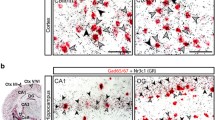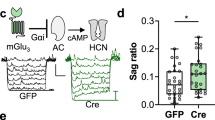Abstract
Glutamatergic dysfunctions have recently been postulated to play a considerable role in mood disorders. However, molecular mechanisms underlying these effects have been poorly deciphered. Previous work demonstrated the contribution of GluA1-containing AMPA receptors (AMPAR) to a depression-like and anxiety-like phenotype. Here we investigated the effect of temporally and spatially restricted gene manipulation of GluA1 on behavioural correlates of mood disorders in mice. Here we show that tamoxifen-induced GluA1 deletion restricted to forebrain glutamatergic neurons of post-adolescent mice does not induce depression- and anxiety-like changes. This differs from the phenotype of mice with global AMPAR deletion suggesting that for mood regulation AMPAR may be particularly important on inhibitory interneurons or already early in development.


Similar content being viewed by others
References
Sanacora G, Treccani G, Popoli M (2012) Towards a glutamate hypothesis of depression: an emerging frontier of neuropsychopharmacology for mood disorders. Neuropharmacology 62:63–77. doi:10.1016/j.neuropharm.2011.07.036
Engin E, Treit D, Dickson CT (2009) Anxiolytic- and antidepressant-like properties of ketamine in behavioural and neurophysiological animal models. Neuroscience 161:359–369. doi:10.1016/j.neuroscience.2009.03.038
Zarate CA Jr, Singh JB, Carlson PJ, Brutsche NE, Ameli R, Luckenbaugh DA, Charney DS, Manji HK (2006) A randomized trial of an N-methyl-D-aspartate antagonist in treatment-resistant major depression. Arch Gen Psychiatry 63:856–864. doi:10.1001/archpsyc.63.8.856
Inta D, Trusel M, Riva MA, Sprengel R, Gass P (2009) Differential c-Fos induction by different NMDA receptor antagonists with antidepressant efficacy: potential clinical implications. Int J Neuropsychopharmacol 12:1133–1136. doi:10.1017/S1461145709990319
Inta D, Filipovic D, Lima-Ojeda JM, Dormann C, Pfeiffer N, Gasparini F, Gass P (2012) The mGlu5 receptor antagonist MPEP activates specific stress-related brain regions and lacks neurotoxic effects of the NMDA receptor antagonist MK-801: significance for the use as anxiolytic/antidepressant drug. Neuropharmacology 62:2034–2039. doi:10.1016/j.neuropharm.2011.12.035
Lima-Ojeda JM, Vogt MA, Pfeiffer N, Dormann C, Köhr G, Sprengel R, Gass P, Inta D (2013) Pharmacological blockade of GluN2B-containing NMDA receptors induces antidepressant-like effects lacking psychotomimetic action and neurotoxicity in the perinatal and adult rodent brain. Prog Neuropsychopharmacol Biol Psychiatry 45:28–33. doi:10.1016/j.pnpbp.2013.04.017
McAllister AK (2007) Dynamic aspects of CNS synapse formation. Annu Rev Neurosci 30:425–450. doi:10.1146/annurev.neuro.29.051605.112830
Machado-Vieira R, Manji HK, Zarate CA (2009) The role of the tripartite glutamatergic synapse in the pathophysiology and therapeutics of mood disorders. Neuroscientist 15:525–539. doi:10.1177/1073858409336093
Kallarackal AJ, Kvarta MD, Cammarata E, Jaberi L, Cai X, Bailey AM, Thompson SM (2013) Chronic stress induces a selective decrease in AMPA receptor-mediated synaptic excitation at hippocampal temporoammonic-CA1 synapses. J Neurosci 33:15669–15674. doi:10.1523/JNEUROSCI.2588-13.2013
Wiedholz LM, Owens WA, Horton RE, Feyder M, Karlsson RM, Hefner K, Sprengel R, Celikel T, Daws LC, Holmes A (2008) Mice lacking the AMPA GluR1 receptor exhibit striatal hyperdopaminergia and ‘schizophrenia-related’ behaviors. Mol Psychiatry 13:631–640. doi:10.1038/sj.mp.4002056
Chourbaji S, Vogt MA, Fumagalli F, Sohr R, Frasca A, Brandwein C, Hortnagl H, Riva MA, Sprengel R, Gass P (2008) AMPA receptor subunit 1 (GluR-A) knockout mice model the glutamate hypothesis of depression. FASEB J 22:3129–3134. doi:10.1096/fj.08-106450
Fitzgerald PJ, Barkus C, Feyder M, Wiedholz LM, Chen YC, Karlsson RM, Machado-Vieira R, Graybeal C, Sharp T, Zarate C, Harvey-White J, Du J, Sprengel R, Gass P, Bannerman D, Holmes A (2010) Does gene deletion of AMPA GluA1 phenocopy features of schizoaffective disorder? Neurobiol Dis 40:608–621. doi:10.1016/j.nbd.2010.08.005
Mathew SJ, Manji HK, Charney DS (2008) Novel drugs and therapeutic targets for severe mood disorders. Neuropsychopharmacology 33:2080–2092. doi:10.1038/sj.npp.1301652
Havekes R, Abel T (2009) Genetic dissection of neural circuits and behaviour in Mus musculus. Adv Genet 65:1–38. doi:10.1016/S0065-2660(09)65001-X
Urani A, Chourbaji S, Gass P (2005) Mutant mouse models of depression: candidate genes and current mouse lines. Neurosci Biobehav Rev 29:805–828. doi:10.1016/j.pbb.2011.02.019
Inta D, Vogt MA, Elkin H, Weber T, Lima-Ojeda JM, Schneider M, Luoni A, Riva MA, Gertz K, Hellmann-Regen J, Kronenberg G, Meyer-Lindenberg A, Sprengel R, Gass P (2014) Phenotype of mice with inducible ablation of GluA1 AMPA receptors during late adolescence: relevance for mental disorders. Hippocampus 24:424–435. doi:10.1002/hipo.22236
Chourbaji S, Pfeiffer N, Dormann C, Brandwein C, Fradley R, Sheardown M, Gass P (2010) The suitability of 129SvEv mice for studying depressive-like behaviour: both males and females develop learned helplessness. Behav Brain Res 211:105–110. doi:10.1016/j.bbr.2010.03.019
Lazic SE, Essioux L (2013) Improving basic and translational science by accounting for litter-to-litter variation in animal models. BMC Neurosci 14:37. doi:10.1186/1471-2202-14-37
Chourbaji S, Brandwein C, Vogt MA, Dormann C, Hellweg R, Gass P (2008) Nature vs. nurture: can enrichment rescue the behavioural phenotype of BDNF heterozygous mice? Behav Brain Res 192:254–258. doi:10.1016/j.bbr.2008.04.015
Chourbaji S, Zacher C, Sanchis-Segura C, Dormann C, Vollmayr B, Gass P (2005) Learned helplessness: validity and reliability of depressive-like states in mice. Brain Res Brain Res Protoc 16:70–78. doi:10.1016/j.brainresprot.2005.09.002
Vogt MA, Chourbaji S, Brandwein C, Dormann C, Sprengel R, Gass P (2008) Suitability of tamoxifen-induced mutagenesis for behavioral phenotyping. Exp Neurol 211:25–33. doi:10.1016/j.expneurol.2007.12.012
Fuss J, Ben Abdallah NM, Hensley FW, Weber KJ, Hellweg R, Gass P (2010) Deletion of running-induced hippocampal neurogenesis by irradiation prevents development of an anxious phenotype in mice. PLoS One 5. doi:10.1371/journal.pone.0012769
Inta D, Vogt MA, Luoni A, Filipovic D, Lima-Ojeda JM, Pfeiffer N, Gasparini F, Riva MA, Gass P (2013) Significant increase in anxiety during aging in mGlu5 receptor knockout mice. Behav Brain Res 241C:27–31. doi:10.1016/j.bbr.2012.11.042
Bannerman DM, Deacon RM, Brady S, Bruce A, Sprengel R, Seeburg PH, Rawlins JN (2004) A comparison of GluR-A-deficient and wild-type mice on a test battery assessing sensorimotor, affective, and cognitive behaviors. Behav Neurosci 118:643–647. doi:10.1037/0735-7044.118.3.643
Freund TF (2003) Interneuron diversity series: rhythm and mood in perisomatic inhibition. Trends Neurosci 26:489–495. doi:10.1016/S0166-2236(03)00227-3
Croarkin PE, Levinson AJ, Daskalakis ZJ (2011) Evidence for GABAergic inhibitory deficits in major depressive disorder. Neurosci Biobehav Rev 35:818–825. doi:10.1016/j.neubiorev.2010.10.002
Filipović D, Zlatković J, Gass P, Inta D (2013) The differential effects of acute vs. chronic stress and their combination on hippocampal parvalbumin and inducible heat shock protein 70 expression. Neuroscience 236:47–54. doi:10.1016/j.neuroscience.2013.01.033
Hu W, Zhang M, Czéh B, Flügge G, Zhang W (2010) Stress impairs GABAergic network function in the hippocampus by activating nongenomic glucocorticoid receptors and affecting the integrity of the parvalbumin-expressing neuronal network. Neuropsychopharmacology 35:1693–1707. doi:10.1038/npp.2010.31
Leranth C, Szeidemann Z, Hsu M, Buzsaki G (1996) AMPA receptors in the rat and primate hippocampus: a possible absence of GluR2/3 subunits in most interneurons. Neuroscience 70:631–652. doi:10.1016/S0306-4522(96)83003-X
Acknowledgments
This work was supported by Deutsche Forschungsgemeinschaft (GA427/11-1) to P.G. and D.I. and the Collaborative Research Center (Sonderforschungsbereich) 636 of the University of Heidelberg to P.G.
Conflict of interest
The authors declare that they have no conflict of interest.
Author information
Authors and Affiliations
Corresponding author
Additional information
Peter Gass and Dragos Inta have contributed equally to this work.
Rights and permissions
About this article
Cite this article
Vogt, M.A., Elkin, H., Pfeiffer, N. et al. Impact of adolescent GluA1 AMPA receptor ablation in forebrain excitatory neurons on behavioural correlates of mood disorders. Eur Arch Psychiatry Clin Neurosci 264, 625–629 (2014). https://doi.org/10.1007/s00406-014-0509-5
Received:
Accepted:
Published:
Issue Date:
DOI: https://doi.org/10.1007/s00406-014-0509-5




